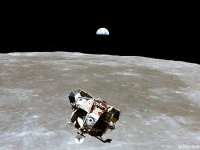India's moon mission placed in lunar orbit
 New Delhi - India's moon mission Chandrayaan-1 was successfully placed in lunar orbit on Saturday, officials at the Indian Space Research Organization (ISRO) said.
New Delhi - India's moon mission Chandrayaan-1 was successfully placed in lunar orbit on Saturday, officials at the Indian Space Research Organization (ISRO) said.
"The lunar orbit insertion placed the Chandrayaan in an elliptical orbit with its nearest point 400 to 500 kilometres away from the moon and the farthest, 7,500 kilometres," ISRO director S Satish said from the southern city of Bangalore.
The complex positioning which depended on precision timing was carried out from the space control room in Bangalore.
"The most critical operation has been successful. All the equipment is working perfectly," ISRO chairman G Madhavan Nair was quoted as saying by CNN-IBN television.
The 1,380-kilogram spacecraft, built by the ISRO, was carried into lunar orbit by a four-stage rocket with six strap-on propellants weighing 12 tons each.
The spacecraft is carrying 11 payloads, five designed by the Indian space agency; three devised and contributed by Germany, Britain and Sweden from the European Space Agency; two from the US space agency; and one from the Bulgarian Academy of Sciences.
The spacecraft's positioning into lunar orbit came after an 18-day journey. The manoeuvre was described as crucial and critical by scientists, who pointed out that at least
30 per cent of similar moon missions had failed at this juncture, resulting in space crafts lost in outer space.
"Our heartbeats stood still in the last 20 minutes," Nair said.
The Chandrayaan-1, described as the cheapest moon mission ever, was launched from the Satish Dhawan Space Centre near the southern Chennai city on October 22.
By November 15, the spacecraft is expected to be orbiting the moon at a distance of 100 kilometres and sending back data and images. The Chandrayaan is also scheduled to send a probe to the moon's surface.
The moon mission's tasks include high-resolution sensing of the moon, preparing a three-dimensional atlas of its near and far sides, chemical and mineralogical mapping as well as searching for the presence of water in its polar regions.
The project cost is estimated at 3.9 billion rupees (about 80 million dollars), about a fifth of similar missions by other countries.
The success of Chandrayaan-1 has catapulted India into the club of space-faring countries, which includes the United States, Russia, Europe, China and Japan.
There has been renewed interest in the moon recently with several of the space powers planning missions to study its resources and use it as a base for space exploration.
China and Japan launched moon missions in 2007 while NASA's Lunar Reconnaissance Orbiter is due for an April 2009 launch. (dpa)